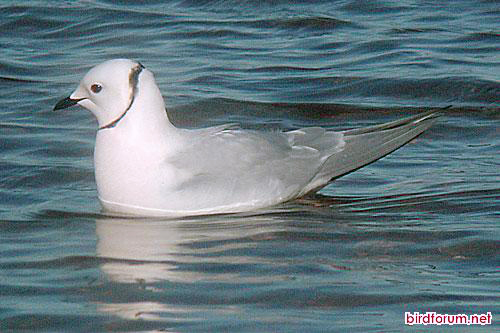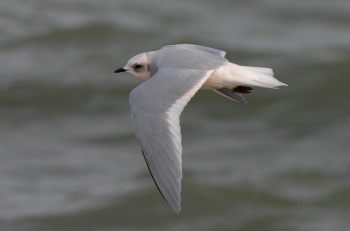- Rhodostethia rosea
Identification
29–32 cm (11½-12½ in)
Summer adult
- Pale grey upperparts
- White underparts
- Pink flush to the breast
- Black neck ring
- Pointed tail
- Red legs
- Short, black bill
Winter adult, the breast tints and neck collar are mostly lost (but remnants remain).
Juvenile has a noticeable "W" pattern across the wings in flight
Similar Species
Little Gull is slightly smaller with hood, pale wingtips (adult), longer bill, and shorter primary projection.
Distribution
Northern Canada and north-eastern Siberia. Vagrant to Britain, north, central and southern Europe
Taxonomy
This is a monotypic species[1], which is sometimes placed in genus Hydrocoloeus.
Habitat
Breeds in swampy arctic tundra.
Sea coasts and coastal lagoons, often perches on ice floes and glacier edges.
Behaviour
Flight
Very bouyant. In a high wind will 'shear' like a Kittiwake and will hover and dip reminiscent of a marsh terns.
Breeding
Two to three eggs are laid in a nest on the ground.
Diet
Its diet includes any small prey and it feeds on mudflats.
Vocalisation
A typical call is "e-wo,e-wo,e-wo", or "kliaw"'.
References
- Clements, J. F., T. S. Schulenberg, M. J. Iliff, T. A. Fredericks, J. A. Gerbracht, D. Lepage, S. M. Billerman, B. L. Sullivan, and C. L. Wood. 2022. The eBird/Clements checklist of Birds of the World: v2022. Downloaded from https://www.birds.cornell.edu/clementschecklist/download/
- Collins Field Guide 5th Edition
Recommended Citation
- BirdForum Opus contributors. (2025) Ross's Gull. In: BirdForum, the forum for wild birds and birding. Retrieved 19 May 2025 from https://www.birdforum.net/opus/Ross%27s_Gull
External Links
GSearch checked for 2020 platform.1






